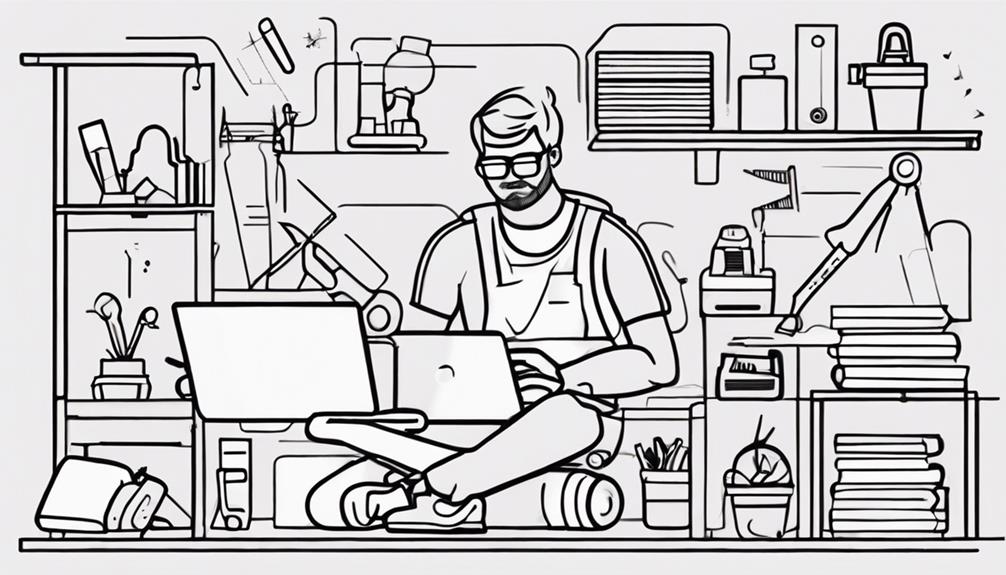You've probably noticed how those little voices in your head can hold you back from achieving your goals. Well, Ryan Hopkins has got some powerful insights to help you break free from those self-limiting beliefs! By recognizing and challenging negative thought patterns, you can start to release your mindset and unleash your full potential. It's all about self-reflection, awareness, and replacing those limiting beliefs with empowering affirmations. With a growth mindset and a dash of self-compassion, you can overcome fear and self-doubt, and start achieving your goals. Want to discover the secrets to unleashing your true potential?
Key Takeaways
- Recognize and challenge negative self-talk patterns to overcome self-limiting beliefs that hinder personal growth and potential.
- Practice self-reflection and awareness to identify and shift core beliefs, replacing them with empowering affirmations for transformation.
- Cultivate self-compassion, resilience, and a growth mindset to overcome fear, self-doubt, and build confidence.
- Reflect on past experiences to understand and let go of limiting beliefs, replacing them with empowering narratives and realistic goals.
- Embrace continuous learning, recognizing the impact of inner dialogue on beliefs, to develop resilience and confidence through positive affirmations.
Identifying Limiting Beliefs and Patterns
To break free from the shackles of self-doubt and unlock your true potential, start by recognizing the subtle yet powerful patterns and beliefs that have been holding you back. You see, self-limiting beliefs are like invisible barriers that prevent you from reaching your full potential. They're like a constant whisper in your ear, telling you that you're not good enough or that you'll never succeed. But here's the thing: these beliefs are often subconscious, which means you mightn't even realize they're there.
The first step to breaking free is to identify these limiting beliefs. Take some time to reflect on your thoughts and actions. What're some things you tell yourself on a daily basis? Are there any negative self-talk patterns that come up repeatedly? What're some things you're afraid to try because you're convinced you'll fail? By recognizing these patterns and beliefs, you can start to challenge them and replace them with empowering ones.
The Power of Self-Reflection and Awareness

When you start to break free from self-limiting beliefs, developing a deeper understanding of your thoughts and emotions becomes crucial.
Through self-reflection and awareness, you'll uncover hidden patterns, identify your core beliefs, and shift your perspective in ways that will amaze you.
Uncovering Hidden Patterns
By taking a closer look within, you'll discover that self-reflection and awareness are the catalysts for revealing hidden patterns of self-limiting beliefs that have been holding you back. Ryan Hopkins emphasizes the importance of introspection in identifying and challenging these limiting beliefs that have been secretly controlling your thoughts and actions.
When you become more aware of your subconscious beliefs, you'll be surprised at how they've been influencing your decisions and behaviors. This newfound awareness is the key to powerful personal transformation and growth. By recognizing these hidden patterns, you can replace limiting beliefs with empowering ones, unleashing your true potential.
Self-awareness and reflection pave the way for breaking free from self-imposed limitations, allowing you to live a more authentic and fulfilling life. So, take the time to look within and uncover those hidden patterns – you might be surprised at what you discover!
Identifying Core Beliefs
As you explore further into the domain of self-reflection, you'll discover that uncovering your core beliefs is the linchpin to understanding what drives your thoughts, emotions, and actions. It's like shining a light on the underlying forces that shape your experiences. By doing so, you'll gain a deeper understanding of what makes you tick, and what's holding you back.
Here are some key takeaways to keep in mind:
- Self-awareness is key: You can't change what you're not aware of. Take the time to reflect on your thoughts, feelings, and actions.
- Your beliefs shape your reality: Your core beliefs have a profound impact on your experiences. Recognize the ones that are holding you back.
- Empowering beliefs are within reach: By challenging limiting beliefs, you can replace them with empowering ones that propel you forward.
- You have the power to choose: You're not a prisoner to your beliefs. You have the ability to transform them and unleash your full potential.
Shifting Perspective
You're now poised to harness the power of self-reflection and awareness, a potent combination that can fundamentally shift your perspective and open the door to overcoming self-limiting beliefs.
By taking a step back to examine your thoughts, feelings, and actions, you'll gain a deeper understanding of what drives you and what holds you back. This introspection is key to recognizing patterns of negative self-talk and self-doubt that can cripple your confidence.
As you become more aware of your thoughts and emotions, you'll begin to challenge those limiting beliefs and replace them with empowering ones. Remember, it's not about being perfect; it's about being honest with yourself and willing to grow.
By cultivating self-awareness, you'll develop a more compassionate and realistic perspective, one that acknowledges your strengths and weaknesses. This shift in perspective will allow you to break free from self-imposed limitations and reveal your full potential.
Challenging Negative Thought Patterns

What's holding you back from achieving your goals: is it the constant barrage of negative self-talk or the fear of taking risks? According to Ryan Hopkins, it's likely a combination of both.
To break free from self-limiting beliefs, you need to challenge those negative thought patterns that are holding you back.
Here are some strategies to get you started:
- Focus on what you can control: Let go of what you can't control and focus on what you can.
- Identify and replace limiting beliefs: Through self-reflection, identify the beliefs that are holding you back and replace them with empowering ones.
- Set realistic goals: Break down your goals into smaller, achievable steps to build confidence and momentum.
- Embrace continuous learning: Keep learning and growing to tap into your full potential.
Embracing Positive Affirmations and Mindset

As you start embracing positive affirmations and a growth mindset, you'll begin to notice a shift in your thoughts and behaviors.
By rewiring negative thoughts and practicing mindful self-talk, you'll be amazed at how quickly you can break free from self-limiting beliefs and tap into your full potential.
Now, let's explore how you can make this transformation a reality!
Rewiring Negative Thoughts
Your thought patterns have the power to either hold you back or propel you forward, making it essential to rewire negative thoughts with empowering affirmations that foster a growth mindset. By liberating negative thoughts, you can break free from self-limiting beliefs and unleash your full potential.
Here are some ways to liberate negative thoughts:
- Challenge negative self-talk: Replace 'I'm not good enough' with 'I'm capable and learning.'
- Focus on the positive: Shift your attention from what's lacking to what you already have.
- Practice gratitude: Reflect on the good things in your life, no matter how small they may seem.
- Celebrate small wins: Acknowledge and celebrate your achievements, no matter how small they may seem.
Mindful Self-Talk Matters
Harnessing the transformative power of mindful self-talk can revolutionize your mindset. Intentionally replacing negative self-talk with empowering affirmations that foster a growth mindset is crucial. As Ryan Hopkins emphasizes, recognizing the impact of your inner dialogue on your beliefs and actions is key.
Through practicing mindful self-talk, you can break free from self-limiting beliefs and cultivate a mindset of growth and possibility.
When you replace negative thoughts with positive affirmations, you'll start to notice a shift in your mindset. This shift will make you more resilient, confident, and empowered to take on challenges.
Consistently practicing mindful self-talk will help you develop a mindset of growth, where obstacles are seen as opportunities for growth and learning.
Remember, it's not about ignoring your flaws or difficulties, but about approaching them with a growth mindset, self-compassion, and resilience.
Overcoming Fear and Self-Doubt

Fear and self-doubt can creep in, whispering negative thoughts that undermine your confidence, but recognizing their presence is the first step in silencing them. According to Ryan Hopkins, overcoming fear and self-doubt requires a deep understanding of the root causes of these feelings.
Through self-reflection and introspection, you can identify the limiting beliefs that hold you back. Here are some strategies to help you overcome fear and self-doubt:
- Replace negative beliefs: Swap out negative self-talk with empowering affirmations that boost your confidence and self-esteem.
- Focus on controllables: Let go of things outside your control and focus on what you can manage.
- Cultivate a growth mindset: Believe that your abilities can be developed, and you'll be more open to learning and growth.
- Practice self-compassion: Treat yourself with kindness and understanding, just as you'd a close friend.
Building Resilience and Confidence

Building resilience and confidence is essential to breaking free from self-limiting beliefs, and Ryan Hopkins' strategies can help you do just that. By focusing on what you can control and letting go of what's beyond your control, you can develop that mental toughness needed to overcome obstacles.
It's time to challenge those limiting beliefs and foster a growth mindset that says, 'Hey, I can do this!' Ryan Hopkins' insights show that self-reflection and positive affirmations are powerful tools to build resilience.
To boost your confidence, try setting realistic goals and celebrating your progress along the way. This isn't about being perfect; it's about making progress and learning from your mistakes. By doing so, you'll develop that mental resilience needed to push past self-doubt and fear.
Breaking Free From Past Experiences

Confronting and reframing the narratives that fuel your self-limiting beliefs is essential as the shadows of past experiences continue to cast a dark influence on your present. You might be wondering, 'How do I break free from the grip of my past?' According to Ryan Hopkins, the key lies in recognizing and letting go of past experiences that contribute to your self-limiting beliefs.
Here are a few ways to start:
- Reflect on your past: Identify how past experiences may be influencing your current beliefs and behaviors.
- Challenge negative narratives: Reframe negative stories from your past to create a new, empowering narrative.
- Practice self-awareness: Introspect and acknowledge how past experiences may be holding you back.
- Create a new narrative: Process your past experiences and create a new story that empowers you to move forward without self-limiting beliefs.
Unlocking Personal Growth and Success

By recognizing and replacing self-limiting beliefs, you can access a transformative path to personal growth and success, where every achievement becomes a catalyst for further progress. As Ryan Hopkins emphasizes, identifying and challenging these beliefs is essential to unleashing your full potential.
| Limiting Belief | Empowering Alternative |
|---|---|
| I'm not good enough | I'm capable and deserving of success |
| I'll never be able to do this | I'll learn and grow from this experience |
| I'm a failure | I made a mistake, and I'll try again |
| I'm not smart enough | I'll ask for help and learn from others |
| I'm too old/young | Age is just a number, and I'm ready to start |
Frequently Asked Questions
How Do I Know if My Beliefs Are Truly Limiting Me?
You wonder if your beliefs are holding you back, but how do you know for sure? Take an honest look at your life: are you stuck, feeling frustrated, or repeating patterns?
Can I Overcome Self-Doubt Without Professional Help?
"You're stuck in a whirlpool of self-doubt, swirling with every negative thought, but here's the lifeline: yes, you can overcome it without professional help, by acknowledging those pesky voices and reframing them into empowering affirmations that propel you forward!"
Is It Possible to Change My Mindset Overnight?
You're wondering if you can flip a mental switch and change your mindset overnight. While it's unrealistic to completely overhaul your mindset in a single night, you can take small steps towards a mindset shift by reframing negative thoughts and practicing self-compassion.
What if My Negative Thoughts Feel More Realistic Than Positive Ones?
You wonder why negative thoughts feel more realistic, but that's because your brain is wired to focus on threats. You can rewire it by practicing self-compassion, reframing negative thoughts, and cultivating a growth mindset.
Can I Still Be Successful if I Don't Completely Break Free?
You're wondering if success is still within reach even if you don't fully break free from self-doubt. The answer is, yes, you can still achieve your goals, but it's like running a marathon with weights tied to your ankles – you'll get there, but it'll be a tougher climb.
How Can Ryan Hopkins’ Insights Help in Overcoming Adversity?
Ryan Hopkins’ insights can greatly aid in overcoming adversity by providing valuable perspectives and strategies. By utilizing katie bullock’s overcoming adversity guide and incorporating Hopkins’ wisdom, individuals can navigate through challenges with resilience and determination. Hopkins’ guidance offers a roadmap for tackling adversity head-on and emerging stronger on the other side.
Conclusion
As you stand at the threshold of a brighter future, remember that breaking free from self-limiting beliefs is a journey, not a destination. It's a path paved with self-awareness, resilience, and determination.
You've got this! Embrace your newfound power, and let it propel you forward like a wildflower blooming in the desert.
You've cracked the code, and now it's time to release your full potential. The world is waiting for the remarkable you – go make it happen!










